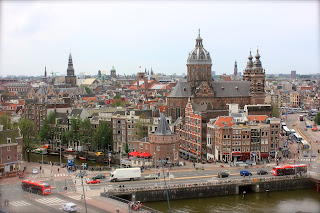The following morning, Martha and I grabbed brekkie at Small
World Catering, a small, Australian-owned joint frequented by ex-pats and
Amsterdammers alike.
Afterwards, Martha suggested I rent a bicycle for the
duration of my stay, to get around Amsterdam like the locals do. With special
bike lanes and traffic lights, it’s the fastest and cheapest way to travel in
and around the city. It also puts the Toronto system to shame.
Before we grabbed my MacBike at Central Station, we checked
out the rooftop view from the SkyLounge on the eleventh floor of the Hilton
Hotel.
While Amsterdam has enough attractions to keep tourists busy for days on end, I decided to take a pass at the Anne Frank House, Van Gogh Museum, and Rijksmuseum. Having visited the city twice before, I was hoping for a more authentic (and outdoors) experience.
In 2013, it has been 400 years since Amsterdam began digging its ring of canals. In celebration of this feat, the city put on an “Open Garden” event, where 30—mostly private—canal houses opened their spectacular gardens to the public. Martha and I biked into and around the canal district, lined with wonky, gabled buildings and houseboats, and visited over 15 gardens along the Herengracht, Keizergracht, and Prinsengracht.
By the Numbers:
* 165 canals
* 14 kilometres of canals
* 2,000 canalside buildings (1,600 of which are historic monuments)
* 800 houseboats
* 80 bridges
* 600+ bikes “disappear” into the canals every year
We took a break at the Spui, a small square in the middle of
town that was busy hosting a bustling book market, where vendors gather each
week to sell their collections of old, rare, second-hand, and out-of-print
books, as well as old prints, pamphlets, posters, and maps. After a bit of
browsing, we popped into the Begijnhof, one of the oldest inner courts in
Amsterdam. As the name suggests, this medieval courtyard was originally a Beguinage,
and now serves private, and—true to its history—female residents. It is also
home to Het Houten Huys, the oldest house in Amsterdam, dating back to 1528.
After a long day out and about in the ‘Stam, Martha and I
headed back to hers for dinner, and took in her stunning canalside view.
























